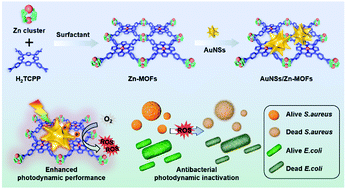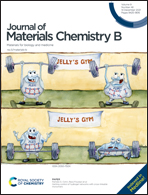Plasmon induced dual excited synergistic effect in Au/metal–organic frameworks composite for enhanced antibacterial therapy†
Abstract
Efficient antibacterial therapy holds great promise for human health. However, it is often limited by the insufficient activity of antibacterial agents. Herein, we demonstrate that the localized surface plasmon resonance (LSPR) excitation of gold nanostars (AuNSs) can dramatically improve the antibacterial activity of a Zn-metal–organic frameworks (Zn-MOFs) nanosheet, which exhibits higher ability to generate reactive oxygen species (ROS) (∼2.5-fold) for bacterial inactivation under light irradiation. Mechanistic investigations demonstrate that the enhancement is closely related to a plasmon-induced “dual excited synergistic effect”. On the one hand, the Zn-MOFs nanosheets as photosensitive agents can be excited to generate ROS with bacterial toxicity. More importantly, abundant plasmonic hot electrons are generated on the surface of AuNSs upon LSPR excitation, which are then transferred from AuNSs into the Zn-MOFs due to the energy matching. As a result, the Zn-MOFs nanosheet presents an electron-rich condition, which activates the adsorbed O2 molecule into a transition state followed by its decomposition into ROS for bacterial inactivation. This study highlights the superiority of LSPR excitation on improving the antibacterial activity of MOFs and provides a novel strategy for effective antibacterial therapy.



 Please wait while we load your content...
Please wait while we load your content...